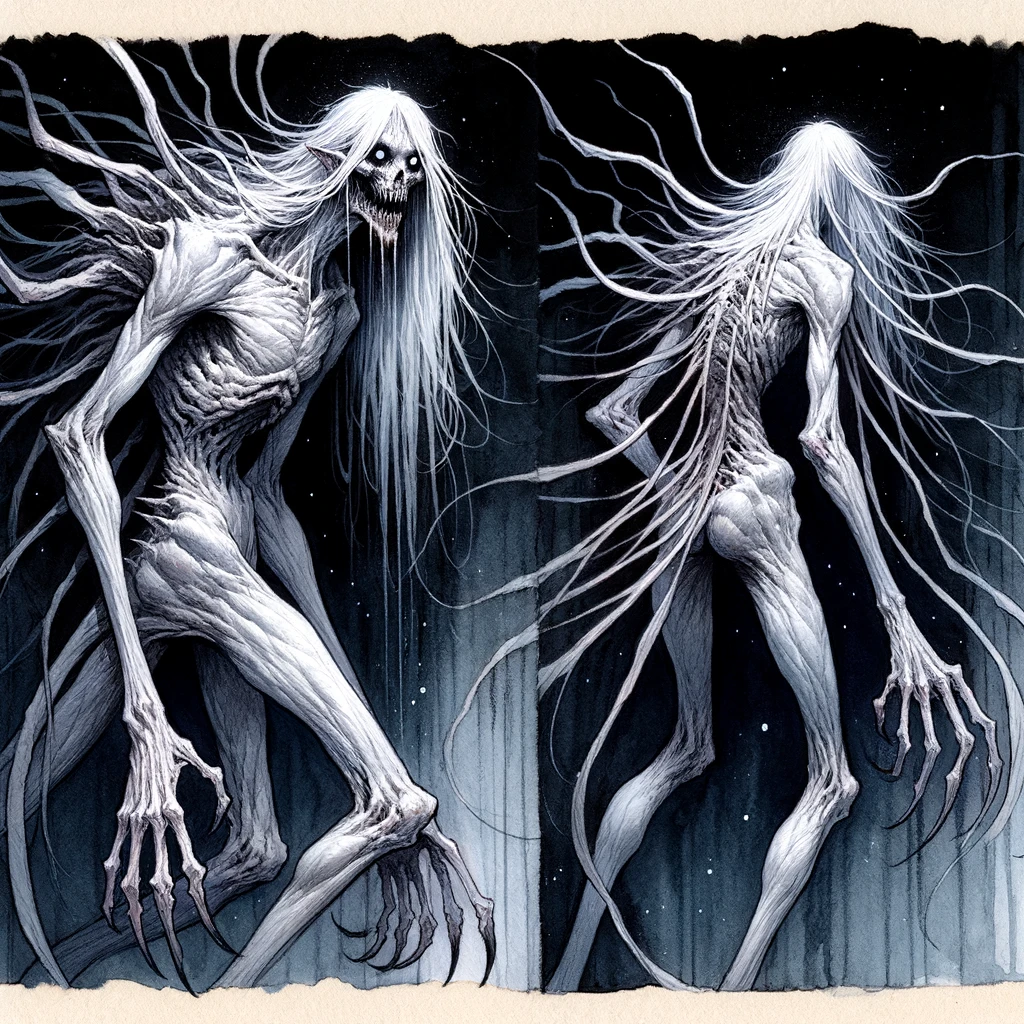Salka
| CLIMATE/TERRAIN: | Carceri, Minethys |
| FREQUENCY: | Very Rare |
| ORGANISATION: | None |
| ACTIVITY CYCLE: | Any |
| DIET: | Carnivore |
| INTELLIGENCE: | Exceptional (15-16) |
| TREASURE: | None |
| ALIGNMENT: | Neutral Evil |
| NO. APPEARING: | 1 (2-4) |
| ARMOUR CLASS: | 2 |
| MOVEMENT: | 15 |
| HIT DICE: | 7 |
| THAC0: | 11 |
| NO. OF ATTACKS: | 3 + special |
| DAMAGE/ATTACK: | 2d6 (bite), 1d6/1d6 (claws) |
| SPECIAL ATTACKS: | See below |
| SPECIAL DEFENCES: | Regeneration, quarter damage from non-magical weapons |
| MAGIC RESISTANCE: | 10% |
| SIZE: | M (6-7′) |
| MORALE: | Fanatic (17-18) |
| XP VALUE: | 8,000 |

Created many ages ago by the corruptive powers of Ialdaboth, the salka are a race of quasi-demonic entities which serve a variety of evil powers. Each salka looks more or less like any other; all are tall humanoid creatures, with pure white skin and eyes, and long flowing silvery-white hair. They are thin, but muscular, and wear upon their sexless bodies a covering of an inky black fluid (this means they suffer only half damage from magical fire and cold, no damage from mundane varieties, and no damage from the stinging sand storms of Minethys). Their mouths are full of vampiric fangs and they have long talons from their fingertips which they use in combat. Most noticeable about the salka is their tendrils. Sprouting from the shoulder blades of each creature is a host of about two dozen (1d4x6 for actual number, evenly distributed between shoulders) tendrils, each about as thick as a pencil and up to five feet long at maturity. Salka do not speak, but instead communicate with each other and other sentient beings through a form of mass telepathy; the only vocal noises they make are snarls, hisses and their horrid banshee-like scream (see below).
COMBAT: Salka fight mainly by the use of their fangs (2d6) and claws (1d6/1d6). They can also make use of their tendrils, with which they often attempt to entangle foes, and hold them bound and nearby while their claws continue to rip at them at the salka’s leisure. After one round of contact by these tendrils, they begin to bore into any given surface or victim (1d4 hit points of damage to any victim, per tendril that makes contact). Favourite targets of salka are the eyes, ears, nose, and mouth, of pinned victims. If a situation occurs where a salka is fighting a creature that it cannot damage, or if it is outnumbered, it can also make use of a scream once every 6 rounds. The scream projects in a cone up to thirty feet and causes 6-36 points of damage upon any non-salka within its path. The damage from the scream is caused by sonic energy, and so deafness is not a protection from the scream, neither is a bard’s counter song ability.
Salka can also use the following abilities: fire shield (hot) 3 times per day, gate another salka (chance dependent upon circumstances, see Society below) Finally, salka can regenerate wounds at a rate of 3 hp per round.
HABITAT/SOCIETY: Salka society is very loose formed at best. They are constantly testing one another and attempting to gain the upper hand in both power and status over other salka, or other demonic beings they are forced to work with. However, they are also fiercely loyal to their masters, fighting to the point of death, and even going out of their way to avenge the death of a master if it seems at all possible. If a salka attempts to gate in additional salka in combat, the chance of response is 50% with 1-3 salka responding. If a salka is simply in a losing battle, the chance is only 25%, and there is a 50% chance that the responding salka will simply wait to see if the attacked salka wins the combat, and then attack it while it’s weakened.
ECOLOGY: Although salka enjoy devouring the flesh of their victims, this rapacity is not a requirement for survival. In fact, salka do not need food, water, nor air to survive. Salka reproduction takes place through their bites. Not everyone bitten by a salka is affected, the salka must willingly choose to transmit the contagion, and the host must be human. After the bite, the human will begin to grow irritated easily, and show a rash upon his or her shoulders as the tendrils begin to grow. Also, the speech of the host begins to flicker back and forth between vocal speech and telepathy, even within mid-sentence. The final period of time it takes for a host to become a salka is between one to two weeks, depending on the conditions; combat, irritation, and stress all force the rapid growth of the salka and are encouraged by the growing fetal force within the host’s spirit. One should note that the salka only rarely choose to infect humans with this though, and usually only do so when on a mission of vengeance, seeking to make the human a salka in order to strengthen their own ranks.
Source: KatClaw and Edamoth



